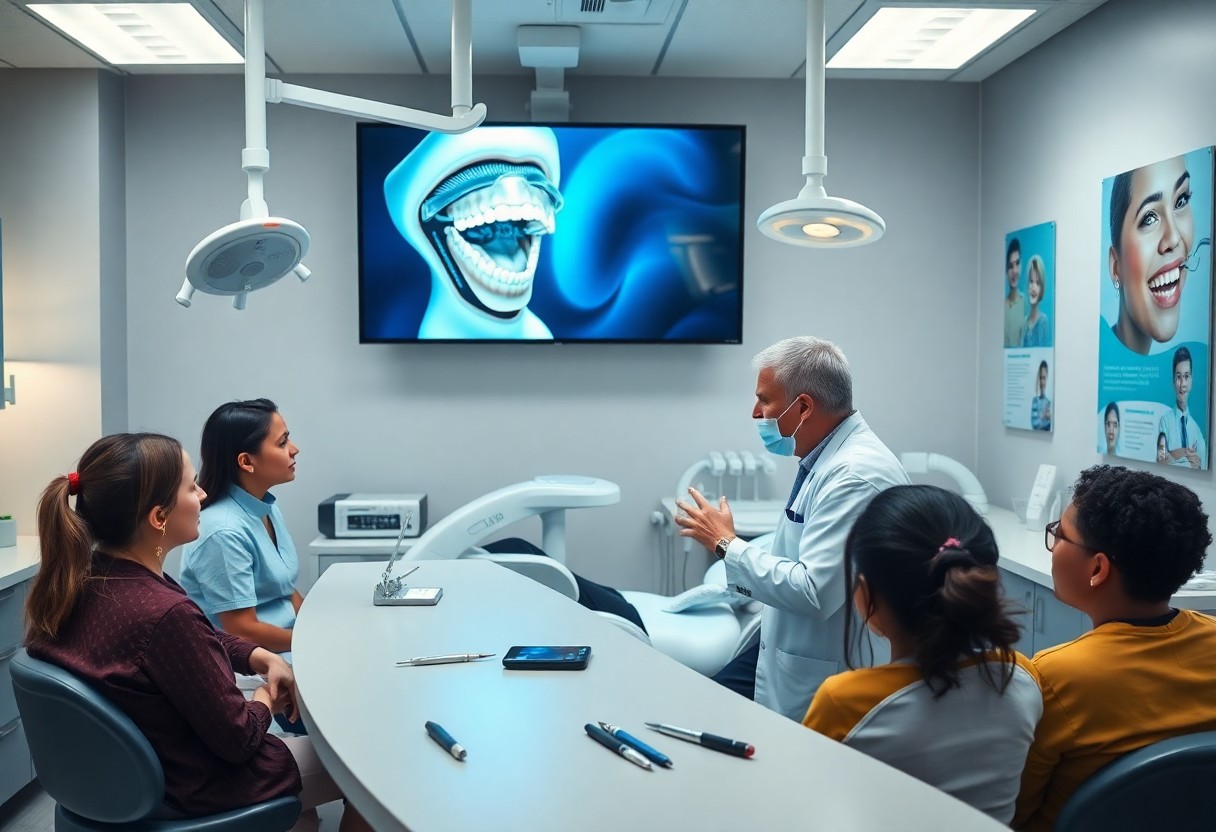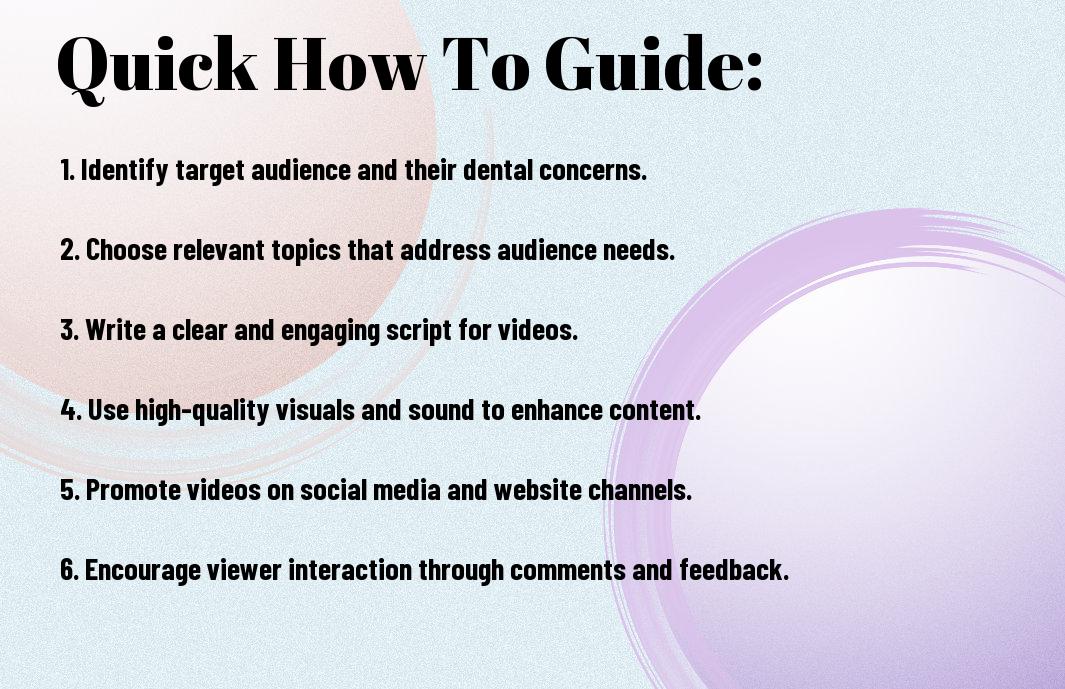How To Create Informative Video Content That Attracts New Dental Patients
Content creation is vital for building a successful dental practice and attracting new patients. In this guide, I will show you how to produce engaging and informative video content that not only showcases your expertise but also helps build trust within your community. You’ll learn how to identify the topics that interest potential patients and how to present them in an appealing way that encourages them to choose your practice. Let’s dive in and transform your dental marketing strategy!

Key Takeaways:
- Define Your Audience: Understand who your ideal dental patients are and tailor your video content to address their specific needs and concerns.
- Engaging Storytelling: Use storytelling techniques to present dental information in a relatable way, making it more likely to attract attention and retain viewers.
- Highlight Services and Expertise: Clearly showcase the dental services you offer and the expertise of your team to build trust and attract new patients.
- Visual Aids: Incorporate visuals such as animations, before-and-after photos, or infographics to simplify complex dental information and enhance viewer understanding.
- Consistency in Branding: Ensure that your videos reflect your dental practice’s brand identity, including logos, colors, and messaging, to create a cohesive online presence.
- Call to Action: Encourage viewers to take specific actions, such as scheduling an appointment or visiting your website, by including clear and compelling calls to action in your videos.
- Optimize for SEO: Use relevant keywords, tags, and descriptions to improve the discoverability of your videos on platforms like YouTube and social media.
Understanding Your Audience
A fundamental step in creating informative video content for your dental practice is understanding your audience. To attract new dental patients, I need to know who they are, what they value, and what dental concerns they might have. In addition to typical demographics, consider the specific challenges and aspirations your potential patients face. This understanding allows me to tailor video content that speaks directly to them, addressing their unique needs. For those interested in enhancing their video marketing strategies, I recommend checking out Video Marketing for Dentists: How To Get Started, which provides valuable insights to promote your practice effectively.
Identifying Target Patients
If I want to create video content that resonates, identifying my target patients is key. This involves researching the demographics, such as age, gender, and location, while also considering their specific dental needs. Are they families looking for pediatric dental care, or are they older adults seeking cosmetic treatments? By segmenting my audience, I can create tailored video messages addressing the specific interests and concerns of each group, enhancing the likelihood of engagement and conversion.
Analyzing Patient Preferences
Audience interests play a significant role in developing effective video content. Understanding what topics your patients are curious about can help me create engaging and informative videos that provide real value. Are potential patients searching for tips on maintaining oral hygiene, or are they more interested in modern cosmetic procedures? By focusing on these preferences, I can ensure my videos not only attract attention but also foster trust and credibility within my community.
Patients today are savvy and have high expectations when it comes to the offerings of dental practices. They seek out information through various channels, and their preferences often lean toward visual content that is not only educational but also entertaining. Statistics show that video content can lead to better retention of information than text-based formats, making it imperative for a dental practice like mine to embrace this medium. Additionally, it is important to highlight patient testimonials, demonstrate procedures, and discuss common questions or fears surrounding dental visits. This approach helps build patient confidence, minimizes anxiety, and ultimately leads to more new patients walking through the door.

Key Factors for Engaging Video Content
One of the primary goals of creating video content is to engage potential dental patients. To enhance your success, consider the following key factors that will make your videos more appealing:
- Quality content: Ensure your videos provide valuable information.
- Authenticity: Be genuine and relatable in your delivery.
- Length: Keep your videos concise and to the point.
- Call to action: Encourage potential patients to take the next steps.
After incorporating these factors, you’ll find that your videos not only attract attention but also foster trust among viewers, converting them into loyal dental patients.
Content Relevance and Value
With every video I create, I focus on ensuring that the content is relevant to the audience’s needs and interests. When potential patients are searching for information online, they are looking for answers to their dental questions or solutions to their problems. By providing valuable insights into dental care, treatment options, and oral health tips, you can effectively position yourself as a knowledgeable expert in the field.
Additionally, I always aim to address common concerns and misconceptions within the dental community. When you focus on topics that resonate with your audience, such as teeth whitening, cavity prevention, or the benefits of regular check-ups, you not only enhance the value of your content but also build a connection with viewers. This approach fosters engagement, encouraging them to explore your dental practice and even schedule an appointment.
Visual and Audio Quality
Content quality is not just about the information you share; it’s also about how aesthetically pleasing and easy to consume your videos are. I cannot overstate the importance of high-quality visuals and crystal-clear audio in capturing attention. Viewers are more likely to engage with videos that look polished and have clear sound, as this reflects professionalism. Invest in good lighting, a steady camera setup, and quality microphones to ensure your videos resonate effectively with your audience.
Value lies in the attention to detail during the production process. High-quality visuals and audio can significantly affect how your message is received; if your content looks and sounds good, viewers are more likely to watch until the end and absorb the information. In contrast, poor-quality production may lead to losing your audience’s interest or even damaging your reputation as a credible dental professional. Prioritizing these aspects will not only enhance viewer experience but also encourage them to trust your services.

Tips for Effective Video Presentation
After creating your video content, the next step is ensuring that the presentation is engaging and effective. I recommend focusing on aspects such as lighting, sound quality, and visual appeal, as they all contribute significantly to how your audience perceives the information you share. Here are some important tips to keep in mind:
- Use high-quality lighting to brighten up your space and diminish shadows.
- Ensure sound is clear and free of background noise.
- Dress professionally to build trust and credibility.
- Keep your framing correct, focusing on your face and expressions.
- Incorporate graphics or animations to illustrate points.
Perceiving your video through the viewer’s lens not only helps you connect with them but also enhances your content’s overall effectiveness in attracting new dental patients.
Planning and Scripting Your Videos
Clearly, having a solid plan and script in place is imperative for creating informative video content. I often find that taking the time to outline your main points leads to a more cohesive and engaging presentation. It helps in structuring the video so that you keep the viewers captivated while clearly providing them with valuable information about your dental practice. I recommend crafting a brief script that allows you to express your personality and expertise without sounding overly rehearsed.
As you plan, you should consider what questions potential patients may have and how your video can effectively address these concerns. This approach not only makes your content relevant but also positions you as a knowledgeable and approachable dentist. Ultimately, your plan serves as a roadmap that guides your content creation while allowing flexibility for those spontaneous moments that resonate with your audience.
Incorporating Storytelling Techniques
Even as healthcare professionals, we often underestimate the power of stories in engaging our audience. When I incorporate storytelling techniques into my video content, I notice a significant impact on viewer retention. By sharing personal experiences or patient success stories, I can convey complex information in an easily digestible format. This approach not only humanizes my practice but also fosters a sense of connection with potential patients who may see themselves in the stories shared.
This technique can be incredibly effective when addressing common dental fears or misconceptions. For instance, sharing a positive patient experience can help deconstruct the negative stigma around dental visits. In these stories, it’s important to highlight positive outcomes, such as improved dental health and enhanced confidence, while also touching on relatable challenges. By weaving genuine narratives into your informative videos, you can create an inviting atmosphere that encourages viewers to choose your dental practice over others.
SEO Strategies for Video Visibility
Your goal should be to maximize the chance of your videos showing up in search results, thereby attracting new dental patients. One of the first steps in achieving this is by focusing on optimizing your video titles and descriptions. I advise you to use relevant keywords that potential patients might input while searching for dental services. Incorporate these keywords naturally into your title and description without compromising on readability. For example, if you produce a video on teeth whitening, include phrases like “teeth whitening options in [Your City]” in your title to help localize your content and attract a specific audience. Additionally, a well-structured description can enhance viewer engagement, encouraging longer watch times, which is favored by search algorithms.
Optimizing Video Titles and Descriptions
Visibility is further enhanced when you create enticing titles and rich, detailed descriptions. Your video title should be catchy enough to grab attention while still being informative. Use active language to direct the viewer’s attention. In your video description, provide an overview of what viewers can expect, including the benefits of the information shared and a call-to-action to book their appointments. Additionally, consider including links to your practice’s website or social media platforms to create a seamless transition for interested viewers.
Utilizing Social Media and Other Platforms
Some may overlook the significant power of social media and other platforms in promoting video content. I strongly encourage you to leverage platforms such as Facebook, Instagram, and LinkedIn to enhance visibility. By sharing your videos across various social networks, you not only tap into different audiences but also increase the chances of your content being shared. Take advantage of features like live sessions and stories to give updates about your dental practice or share valuable tips, thereby creating a more personal connection with potential patients.
A major aspect of utilizing social media is the ability to engage with your audience actively. An effective strategy is to respond promptly to comments and messages, creating a dialogue that builds trust. You can also collaborate with local influencers or health professionals, as their endorsements can drive traffic to your videos. Keeping your content fresh and engaging on social media can lead to higher engagement levels, which will ultimately contribute to a more prominent online presence and help attract new patients to your dental practice.
Measuring the Impact of Your Video Content
Unlike traditional marketing strategies, the digital landscape offers a wide array of metrics to evaluate the success of your video content. It’s imperative to analyze not just how many people watched your video, but also how engaged they were with it. I find that metrics such as watch time, click-through rates, and conversion rates provide deep insights into how well the content resonates with potential dental patients. By understanding these numbers, you can adapt your approach, ensuring that your video content effectively attracts and holds the attention of new patients.
Tracking Engagement Metrics
Even small shifts in viewer engagement can indicate significant changes in your audience’s perception of your practice. You should monitor metrics like average view duration and audience retention to assess whether potential patients are finding your content valuable. A high drop-off rate at a specific point in your video may signal that it is time to reevaluate its content or presentation style. By continuously tracking these engagement metrics, you can stay ahead of trends and preferences, adapting your strategy accordingly to foster more meaningful connections with your audience.
Gathering Patient Feedback
Any feedback you receive from patients can be an invaluable source of information regarding the effectiveness of your video content. I always encourage my audience to leave comments and questions, whether on social media or directly through the video platform. Engaging with patient feedback not only shows you care about their opinions but also provides you with insight into what aspects of your videos they find most appealing or helpful. You might discover specific topics they want to learn more about, allowing you to tailor future content closely aligned with their needs.
It’s also important to analyze the types of feedback you receive; positive comments can help reinforce what you’re doing right, while constructive criticism allows for improvement. You may consider creating surveys or polls to gather more structured feedback, giving potential patients an avenue to voice their thoughts and suggestions directly. This engagement can bolster your relationship with your audience and positions your dental practice as one that values patient opinions and strives for continuous improvement.
Best Practices for Regular Content Creation
Keep in mind that creating informative video content isn’t just a one-off task; it’s a long-term commitment that requires a thoughtful approach. By developing a systematic routine for producing and sharing content, I can ensure that my efforts lead to sustained engagement and attract new dental patients over time. This is where a well-structured content calendar comes into play, allowing me to plan out content topics, recording dates, and publication schedules that align with my practice goals.
Creating a Content Calendar
One effective strategy I utilize is crafting a content calendar that outlines my video production schedule for the upcoming months. By mapping out themes and specific topics ahead of time, I can keep my content fresh and relevant, ensuring it resonates with potential patients’ interests and concerns. This approach not only helps me maintain consistency in video uploads but also allows me to plan ahead for significant dates such as National Dental Hygiene Month or Back to School season, aligning my content with timely subjects that my audience cares about.
Balancing Quality and Consistency
Any successful content creator will tell you that striking the right balance between producing high-quality videos and maintaining a regular upload schedule is fundamental. If I prioritize consistency at the expense of quality, my audience may disengage, but if I focus solely on quality, I might find myself posting infrequently, which can lead to diminished visibility and a loss of audience interest. Thus, it’s vital to carve out enough time to create engaging, valuable content while also committing to a feasible posting frequency.
Plus, by using resources like video editing software and tools for enhancing production quality, I can elevate my content without sacrificing timeliness. If you invest the time to learn about trends in dental health, consider what your target audience is asking online, and implement feedback from previous videos, you’ll be generating content that is both informative and share-worthy. That way, you can create a win-win situation: patients receive valuable information, and you build your presence as a trusted dental expert in your community.
Final Words
Following this guide, I hope you feel equipped to create engaging and informative video content that resonates with potential dental patients. By focusing on their needs and concerns, you can demonstrate the value of your services and build a connection with your audience. Consider exploring different formats, such as Q&A sessions, patient testimonials, or educational how-tos, to keep your content diverse and appealing. The key is to deliver information that is not only interesting but also useful, so your viewers feel empowered to make informed decisions about their oral health.
As you begin on this journey of content creation, I encourage you to analyze the performance of your videos regularly. Take note of what works and refine your approach based on feedback and engagement metrics. The more you understand what attracts your audience, the better you can tailor your content to meet their needs. I look forward to seeing you thrive in establishing a strong online presence that drives new patients to your dental practice.
FAQ
Q: What type of video content is most effective for attracting new dental patients?
A: Effective video content includes patient testimonials, virtual office tours, educational videos on dental procedures, tips on oral care, and frequently asked questions about dental services. This variety engages potential patients and showcases different aspects of your practice.
Q: How long should my informative dental videos be?
A: Aim for videos that are 1 to 3 minutes long. This duration allows you to convey important information without losing the viewer’s attention. Keeping content concise and engaging is key to maintaining interest.
Q: What platforms should I use to publish my dental videos?
A: Consider using platforms like YouTube, Facebook, Instagram, and your practice’s website. Each platform has its audience and can increase the visibility of your videos. Engaging with viewers through comments and shares on social media can also boost your outreach.
Q: How can I ensure my videos are SEO-friendly to attract more viewers?
A: Optimize your video titles with relevant keywords, write detailed descriptions, and include tags related to dental care. Additionally, using closed captions can improve accessibility and SEO rankings. Promoting videos on your website and social media further enhances visibility.
Q: What kind of equipment do I need to create professional-looking dental videos?
A: While high-end equipment is beneficial, starting with just a good smartphone camera and a tripod can be sufficient. Ensure you have proper lighting and a decent microphone to enhance video quality. As your skills improve, you can invest in more advanced equipment.
Q: Should I include patient testimonials in my videos, and how do I approach this?
A: Yes, patient testimonials can be persuasive. Approach your patients politely, explaining the purpose of the video and how it may help others. Ensure that you obtain written consent to share their story. Authentic testimonials build trust and can influence potential patients’ decisions.
Q: How can I promote my informative dental videos to reach a larger audience?
A: Share your videos on social media channels, email newsletters, and your website’s blog section. Collaborate with local businesses to cross-promote content and consider running paid ads on platforms like Facebook and Google for broader reach. Engaging with viewers in the comments can further enhance relationships and visibility.




